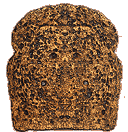Marat Guelman,
curator
 Normally, an exhibition is preceded by a conceptual text to which the artists respond in some way. Then, the theme gets filled out with meanings, works, an artistic language, and as a result, a show comes together. For the exhibition "Russian Povera," not a single work was made specifically to accommodate the concept. Our project has brought together that which has already come about, and the few pieces that were commissioned for the exhibition are part of the overall flow of their makers' work. Due to this, "Russian Povera" is a general overview of Russian art and not a thematic exhibition; that which has already happened acquires its name in this project.
Normally, an exhibition is preceded by a conceptual text to which the artists respond in some way. Then, the theme gets filled out with meanings, works, an artistic language, and as a result, a show comes together. For the exhibition "Russian Povera," not a single work was made specifically to accommodate the concept. Our project has brought together that which has already come about, and the few pieces that were commissioned for the exhibition are part of the overall flow of their makers' work. Due to this, "Russian Povera" is a general overview of Russian art and not a thematic exhibition; that which has already happened acquires its name in this project.
Of course, in naming the show "Russian Povera," I fully realize the consonance with the Italian Arte Povera, but even given the many similar formal elements, I also find the difference obvious - as obvious as the difference between starving out of poverty and refusing to eat for the benefit of one's health and figure.
The artists taking part in "Russian Povera" have never thought of themselves as a single group with a common aesthetic - unlike Arte Povera, which was a movement with a unified aesthetic manifesto. Therefore, "Russian Povera" is a unique exhibition insofar as it presents art to art and gives the artists a reason to consider that which they have in common. The exhibition presents this not as a reason for disappointment, but as something which shows itself despite our will and with which we can enter the history of world art.
An inner turn to art made out of simple materials is just as archetypal as the myth of the poor artist who makes art out of nothing. It's magic.
"Poor" art has an important subtext - its naturalness. It is much closer to nature than art that is rich, glossy, and built on technologies. The very material of "poor" art returns us to naturalness, breaks down the border between natural and artificial. This art grows out of nature itself.
For twenty years, I have been approaching some understanding of art, and each show is an aspiration to convey my current understanding, some broader picture. Each time, it is a fragment of the whole, but one that says something important about what is going on in art in general.
Today, art and artists are busy separating themselves from the spheres that they themselves brought into being.
|
 |
For example, there exists a threat to art from the direction of design. At international fairs, two thirds of the works are excellent designer objects. But design, unlike art, is a mass profession, which has its own technologies, a lot activity, and aggression. Therefore, an artist should block himself off from that.
At some point, art went down the path of communicational openness, of performance, and on its own created certain forms of interactive art as a particular type of entertainment. Now, entertainment also endangers art and threatens to invade its territory.
And most importantly, there is that which is called by the generic term "glamour." Aesthetics has become a science; it has spawned easily reproducible standards of beauty and glossy journalism. Mona Lisa looks at us from all the glossy magazines. And from this too art tries to separate itself.
By various means, art builds its own space.
"Poor" art, in my opinion, is what real art is. Wealth has migrated to other spheres; it has been co-opted, consumed, has turned into advertising, design, magazine beauty, what you will, having lost the ability to be art. Artists working with the aesthetic of the "poor," I am certain, think exactly this way.
This exhibition has a strong impulse for sharing its vision in social aspects. Better than anyone else, I understand how distorted the perception of contemporary Russian art is. There exists a clear concept of political art, and it is easily accepted by the West: if a country is unfree, then art should be socially aware and express protest. Because of this one-sided view, the most significant of names - Koshlyakov, Brodsky, Polissky - have fallen out of contemporaneity. They exist, but there is no discussion, no acuity of interest around them.
"Russian Povera" provides a different vision of contemporary art. It's a look from the position of a "poor" aesthetic at Russian art as a whole, and precisely because of this, aside from artists key for this theme, the exhibition contains works by a wide array of others.
This is a different look - an attempt at correcting the optics of examining Russian art. "Povera" turned out to be a very precise key to the understanding of our art as a whole. Today, success comes to clear images and clear artistic projects, and our exhibition helps to make looking at Russian art clearer.
|